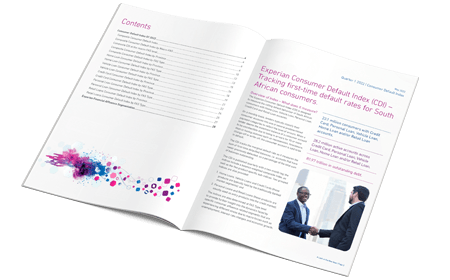
The Experian Data Insights Check-In brings you key insights based on the Q1 2022 Consumer Default Index. Our analytics experts have extracted key highlights to give you a good understanding of the current trends we’re seeing in the market.
Short and to-the-point, these key trends leave you with enough information to start making better business decisions.
Listen to the Podcast
No time to read the article below? Listen to our podcast.
Experian Data Insights Check-In – Q1 2022 CDI Key Insights
5-minute read
The Experian Consumer Default Index (CDI) is designed to measure the rolling default behaviour of South African consumers with Home Loan, Vehicle Loan, Personal Loan, Credit Card and Retail Loan accounts.
On a monthly basis, lenders typically classify their consumer accounts into one of several predetermined payment categories to reflect the level of arrears. When a lender deems the statement balance of a consumer account to be uncollectible due to being in arrears for 90 or more days or having statuses such as repossession, foreclosure, charge-off or write-off, the consumer account is said to be in default.
The index tracks the marginal default rate as it measures the sum of first-time defaulted balances, i.e., accounts that have never previously defaulted, as a percentage of the total sum of balances outstanding.
The CDI showed a meaningful increase (deterioration) Q-o-Q, moving from 3.45 in 2021 Q4 to 3.68 in 2022 Q1. Y-o-Y, however, a significant improvement was observed, moving from 4.39 in 2021 Q1 down to 3.68 in 2022 Q2.
The Y-o-Y improvement was observed for all products. Relatively speaking, the improvements observed for Credit Card and Personal Loans were the most significant, with both of these products showing a relative improvement in CDI of almost 23%.
On a Q-o-Q basis, we saw quite a significant deterioration in the CDI for Retail Loans, moving from 10.41 in 2021 Q4 to 10.97 in 2022 Q1. This deterioration in Q1 is typical for unsecured credit products, following the flurry of new credit (especially short-term credit) being taken up during the festive season in Q4. Retail is probably the credit product that sees the most significant ‘spike in activity during the holiday season.
Retail Loans is the product set in which the least affluent consumer groups FAS 4, 5 & 6, hold the most significant portion (~60%) of the market.
Indeed, considering the last 3 years’ total ‘current balance’ reflected for Retail loans, we see this seasonal pattern of increased exposure in the Retail vertical, come holidays, Black Fridays and the like, repeating itself. We have noticed COVID-19 putting a significant dampener on the typical size of this spike, but it would seem that 2021 Q4 saw the relative increase in total exposure in the Retail sector over the festive period returning to levels more resembling of pre-COVID movements.
Looking at the long-term trend (over and above the typical seasonality in the data), we see that the COVID-carnage resulting in significant decreases in Retail Loans new business, has started to change direction in momentum, in the sense that the total exposure in this sector has shown a slowing rated of decreased exposure, to an almost flat-line over the last few months. This suggests that the Retail lending vertical is picking its head up and showing signs of new life.
Following on from these signs of new life, as well as the seasonal ‘spike’ in exposure during the Festive season, it is not surprising to see a default-related metric such as the CDI, showing deterioration towards the latter part of Q1 then – and in this case, both on a Q-o-Q and Y-o-Y basis.
Our expectation is to see further deterioration in the Retail CDI in the short-term (typical of Q2 observations for this sector). In the long-term, as this sector starts to show a long-term increase in exposure, the CDI is also expected to show further deterioration – also as providers become less risk averse and look more to grow and expand on their business in the post-pandemic era.
Considering the expected movement of the Composite CDI, we expect a similar movement, with the typical Q2 local peak in CDI. Also, in the longer term, a steady deterioration of the CDI is foreseen, similar to the long-term movement observed prior to the onset of COVID.

Get the Q1 2022 CDI Report for a more detailed view of the latest consumer default trends.
Get CDI Report
Watch the Video
Watch our video in which Ans takes you through the various graphs that bring these data insights to life.
